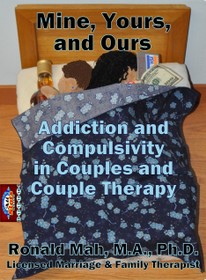19. Therapeutic Relapse - RonaldMah
Ronald Mah, M.A., Ph.D.

Licensed Marriage & Family Therapist,
Consultant/Trainer/Author
Main menu:
19. Therapeutic Relapse
Therapist Resources > Therapy Books > Mine Yours Addiction- Cpl

Mine, Yours, and Ours, Addiction and Compulsivity in Couples and Couple Therapy
Chapter 19: THERAPEUTIC RELAPSE

Therapy must present recovery from a growth perspective. Relapse is normalized as an aspect of a progressive recovery process. "Sarah explained: [The therapist] told both of us what to expect. He said, 'The chance that you will relapse is so high, but that is okay… We talked about how you need to handle this… You're prepared if [you do relapse].' I think that made a really big difference because all of a sudden… it wasn't like Steve felt like he gave him permission to [relapse], but instead it took a lot of pressure off. I think it almost made it easier to stay away… because there is not as much pressure to stay away? Steve explained what it meant to him to keep things in perspective: 'Telling myself that I am a good person, regardless of what my problems are, and that no matter where I am in the process, as long as I am trying, even if I am failing, I shouldn't be beating myself up'" (Zitzman and Butler, 2005, page 237). The therapist must push for depth and nuance of the relapse process. Every action, choice, and especially mistake offers potential therapeutic insight and guidance for change and growth. Each and every decision or choice taken or not taken needs to be examined for alternative directions that can be taken the next time. As such, the therapist's emphasis is on reasons versus excuses. Excuses are exposed as one absolving oneself of responsibility and having made poor choices. On the other hand, when reasons for choices or behavior are determined, they direct problem-solving behavior based on having personal power and control. "What did you decide to do?" "What was an alternative you considered?" "What could you have done differently?" "What would have been a hard thing to do then… to do instead?" "What if you had done that instead of this?" At each decision or choice fork in the road, the therapist prompts for alternate routes to consider and to take and attempt next time. The therapist continues to engage the individual and the couple to identify as many points of potential diversion from the problematic path previously taken. In addition to providing a roadmap for the next crisis, this process asserts the multiplicity of options and choices available. It reinforces personal responsibility to counter a victim or helpless stance that leaves no alternatives other than withdrawal, quitting, or self-medicating with substance or behavioral abuse.
As their work worlds became more demanding for the couple, both Gwyn and Cybil became less vigilant about their self-care behaviors (breaks, recreation, diversions, sports/exercise, etc.) and their intimacy behaviors (dates, cuddling, sex, and time to connect and communicate in general). Eventually, a sense of deprivation for one or the other erupted into negative behavior (snapping over small miscues, passive aggressive behavior, etc.). Cybil as the non-addicted partner would feel unappreciated and retaliate with similar behaviors. Cybil had family memories of horrific emotionally toxic battles between parents. Withdrawing to the bedroom and into a lonely solitary world was the only option as a child. As an adult, Cybil shut down and hoped that the anger and pain would pass. Gwyn's family-of-origin experiences were of mutual domestic violence between parents. Flashing rage and nasty comments was an improvement for Gwyn compared to the battle royale from childhood. With Cybil, Gwyn would erupt and then step back and be sullen. The immediacy of the argument would recede over time as they "got past" it. As they supposedly got past one fight and injury after another, they did not resolve the fundamental issues underlying their conflicts. Over time, their accumulation of resentments became explosive and a major fight ensued with horrific hurtful accusations flying about. They both went close to repeating their mutual devastating family-of-origin models. Traumatized by the viciousness of the battle and deeply injured, both partners silently colluded in avoiding dealing with the underlying issues by focusing on work and child-raising responsibilities. Self-care and intimacy behaviors again suffered and the cycle of deprivation/fighting/silent collusion continued devolving to another even more volatile and dangerous level, as well as drinking binges for Gwyn previously. A final fight that brought Gwyn to the brink of another binge despite the knowledge that further alcohol consumption threatened her life. Drinking again or divorce as the next step brought them to couple therapy.
The beginning of therapy delved deeply into identifying the pattern and process of the couple's dynamics. The therapist's prediction that Gwyn and Cybil would re-cycle the identified pattern and process was readily accepted. The couple had experienced it so many times before. A plan (Plan I) was readily developed for each member of the couple to engage in more self-care behaviors and for the couple to have more frequent intimacy behaviors: regular exercise time, scheduled couple's dating time, check-in routines established, and so forth. Rather than assuming that the couple would follow through on the plan, the therapy focused on how either or both of them would mess the plan up- that is, sabotage the plan. Cybil identified how work demands often resulted in de-prioritizing self-care and relationship maintenance. Staying up late to get projects done for deadlines, shorting sleep, eating fast food, forgetting to check in with Gwyn, holding frustrations inside without informing Gwyn, and skipping workouts were part of the pattern of self-sabotaging personal care. Gwyn admitted being lax about taking her medication for her conditions. Children having academic or social problems at school and demands from her parents tended to disrupt her. In addition, Gwyn would become jealous when a sister or brother spent money on a vacation or luxury the two of them could not afford. This caused a sense of deprivation that became a sense of entitlement to make self-medicating choices. Feeling the weight of these issues, Gwyn tended to do the gratuitous non-productive things that increased rather than improved stress issues and the relationship. This included forgoing the quiet times that were centering, sharing a meal, reading for pleasure, and talking with Cybil, amplified the stress. Various individual and joint stresses, demands, deferring self-care, distractions, and so forth had previously sabotaged well-intended plans. These failures were identified and became fuel for therapeutic change. From these a specific plan (Plan II) beyond "trying harder" was discussed next to prevent disrupting positive growth, specifically self-sabotage. The partners agreed to empower each other to intervene or prompt the other when slipping from positive behavior. Part of the plan included coming to therapy once a week to check in about stress levels and whether or not they were collectively and individually addressing self-sabotage behaviors and following through on productive behaviors.
POSITIVE OR NEGATIVE OUTCOME—DECONSTRUCTION
Often, the next couple's session becomes a deconstruction of either the positive outcome or the negative outcome of various plans. With a positive outcome, a partner often ascribes the success to the other partner behaving well. For example, Gwyn might say, "We did well this week because Cybil was in a good mood. So, I didn't want to drink." While this may be relevant, the therapist needs to focus each partner on what he or she has done well or chosen well. "What did you, Gwyn do differently? Don't tell me right now about what Cybil did or didn't do. You, Cybil… and what did you do?" "What good choices did you make?" "What bad choice did you almost make, but didn't?" Attributing positive outcomes solely to the other partner's behavior or choices asserts that the first partner is powerless to create change in the relationship. This declares that it is up to the magnanimous choices of the other partner that the relationship improves or not. If Gwyn, for example presents that what happens between them is up to what the Cybil does or does not do, then Gwyn therefore does not have responsibility to create change in the relationship or change. The following statements by Gwyn express personal choice and responsibility. "Well, I made sure I was home early enough every night this week to make sure I had time to check in with Cybil." "I wanted to drink but I called my sponsor to talk." "I got a sitter so me and Cybil could have dinner out." "I started to blow up on Cybil, but decided… made myself talk about it." "I would have gone off on Cybil before, but I made myself slow down and gave Cybil a chance to explain what it was supposed to be about." The therapist also prompts similar statements of positive choices by Cybil regarding herself and Gwyn.
If the couple reports there have been negative outcomes from session to session, the therapist reasserts individual responsibility for choices. Each partner often wants to blame the other person for problems, while failing to look at his or her own choices and behaviors. Gwyn starts out with, "Cybil didn't…" "Cybil brought home work…" The therapist should interrupt and be very assertive at challenging each partner, "Don't tell me about what Cybil did or didn't do to mess up. Gwyn, what did you do or not do to mess up?" When Cybil complains about Gwyn, the therapist should assert, "I don't want to hear about Gwyn. Cybil, what did you do or not do?" As with positive outcomes, the therapist emphasizes individual choices to reinforce individual responsibility versus personal helplessness. Prior therapeutic work identifying the historical negative patterns of behavior will allow the therapist to label the current behavior as the individual or couple's sabotaging pattern. In other words, the earlier prediction of misbehavior or self-sabotage or sabotage is confirmed through their action and choices. The therapist can try to prompt the following types of statements, by asking each partner to verbalize: "Gwyn, finish this comment. 'I keep it inside me when I got annoyed about…'" "Cybil, fill in the blank, 'I chose to ______ as the easy way out like I always do.'" The therapist can ask questions such as, "When your partner did that, what did you chose to do? What is so compelling about that choice?" When one partner complains about the other, the therapist can feed back, "So you got annoyed and kept it inside like you've done before. Is that right?" "It seems like choosing the easy way out... or doing the same ol' thing got you the same result. Right?" With these and similar interventions, the therapy then can go to what should have or could have been done instead... could have been tried. That would be how each partner or either partner can make different choices.
Breaking a negative pattern is seldom easy. The fact of the pattern indicates how it is entrenched. The therapist may need to try various tactics to break negative patterns and develop positive patterns. Within developing a process for success and growth, identifying plans for action and dealing with self-sabotage will run up against the full spectrum of underlying psychodynamic, cultural, emotional, and other challenging issues. These often complex issues must often be addressed simultaneously with other actions to break the individual and couple's negative cycles. This often depends on the artistic skills of the therapist. The art of therapy however is founded on the craft, skills, and conceptual wisdom from sound theories of human functioning. Both development of negative patterns and of positive patterns of life functioning can and should be logically conceptualized by the therapist. Initial assessment and initial stages of therapy need to be sound and set the sequence and progression to build on for the overal therapeutic process.

